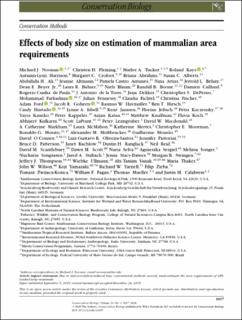Effects of body size on estimation of mammalian area requirements
Noonan, Michael J.; Fleming, Christen H.; Tucker, Marlee A.; Kays, Roland; Harrison, Autumn-Lynn; Crofoot, Margaret C*; Abrahams, Briana; Alberts, Susan C.; Ali, Abdullahi H.; Altmann, Jeanne; Antunes, Pamela Castro; Belant, Jerrold L.; Attias, Nina; Beyer Jr., Dean E.; Bidner, Laura R.; Blaum, Niels; Boone, Randall B.; Caillaud, Damien; De Paula, Rogerio Cunha; de la Torre, J. Antonio; Dekker, Jasja; DePerno, Christopher S.; Farhadinia, Mohammad; Fennessy, Julian; Fichtel, Claudia; Fischer, Christina; Ford, Adam; Goheen, Jacob R.; Havmøller, Rasmus W.; Hirsch, Ben T.; Hurtado, Cindy; Isbell, Lynne A.; Janssen, René; Jeltsch, Florian; Kaczensky, Petra; Kappeler, Peter; Kaneko, Yayoi; Katna, Anjan; Kauffman, Matthew; Koch, Flavia; Kulkarni, Abhijeet; LaPoint, Scott; Leimgruber, Peter; Macdonald, David W.; Markham, A. Catherine; McMahon, Laura; Mertes, Katherine; Moorman, Christopher E.; Morato, Ronaldo G.; Moßbrucker, Alexander M.; Mourão, Guilherme; O’Connor, David; Gustavo R, Luiz; Oliveira-Santo, Luiz Gustavo R.; Pastorini, Jennifer
Peer reviewed, Journal article
Published version

Åpne
Permanent lenke
https://hdl.handle.net/11250/2686106Utgivelsesdato
2020Metadata
Vis full innførselSamlinger
- Publikasjoner fra CRIStin - NINA [2399]
- Scientific publications [1425]
Originalversjon
10.1111/cobi.13495Sammendrag
Accurately quantifying species’ area requirements is a prerequisite for effective area-based conservation. This typically involves collecting tracking data on species of interest and then conducting home-range analyses. Problematically, autocorrelation in tracking data can result in space needs being severely underestimated. Based on the previous work, we hypothesized the magnitude of underestimation varies with body mass, a relationship that could have serious conservation implications. To evaluate this hypothesis for terrestrial mammals, we estimated home-range areas with global positioning system (GPS) locations from 757 individuals across 61 globally distributed mammalian species with body masses ranging from 0.4 to 4000 kg. We then applied block cross-validation to quantify bias in empirical home-range estimates. Area requirements of mammals <10 kg were underestimated by a mean approximately15%, and species weighing approximately100 kg were underestimated by approximately50% on average. Thus, we found area estimation was subject to autocorrelation-induced bias that was worse for large species. Combined with the fact that extinction risk increases as body mass increases, the allometric scaling of bias we observed suggests the most threatened species are also likely to be those with the least accurate home-range estimates. As a correction, we tested whether data thinning or autocorrelation-informed home-range estimation minimized the scaling effect of autocorrelation on area estimates. Data thinning required an approximately93% data loss to achieve statistical independence with 95% confidence and was, therefore, not a viable solution. In contrast, autocorrelation-informed home-range estimation resulted in consistently accurate estimates irrespective of mass. When relating body mass to home range size, we detected that correcting for autocorrelation resulted in a scaling exponent significantly >1, meaning the scaling of the relationship changed substantially at the upper end of the mass spectrum.
